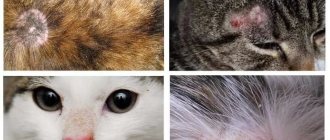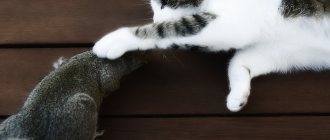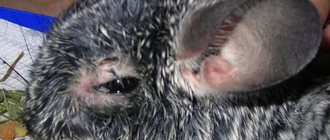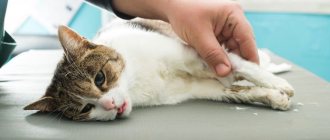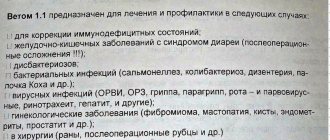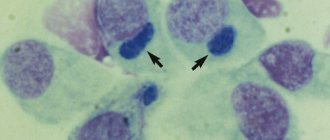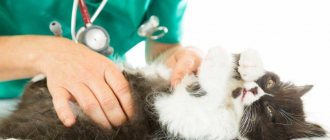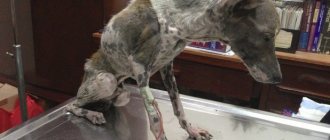There are 4 forms of microsporia in cats:
- Hidden (when the disease is practically invisible, the lesions are sometimes not expressed at all);
- Erased (the animal has small hairless areas of skin);
- Superficial (there is mild inflammation on the skin, hair may fall out, forming small and few bald spots);
- Follicular (large area of baldness, the skin on the affected areas is covered with crusts, severely inflamed, and may fester).
Photos of microsporia in cats:
See also:
maine coon photos
Symptoms of microsporia in cats
General symptoms, depending on the form of the disease, are usually as follows:
- Deterioration in the cat's appearance (dull coat, dandruff, dry skin, brittle fur);
- The appearance of a gray coating on the fur;
- Restless behavior of the animal (the cat scratches the affected areas of the skin every now and then);
- Formation of round and oval areas with broken or missing hairs (most often the lesions are located on the muzzle, paws, tail);
- The animal's skin becomes pale and unhealthy in appearance;
- The appearance of itching, which causes scratching and then peeling of the skin;
- Proliferation of bald spots in the absence of treatment;
- The appearance of wounds, peeling, suppuration on the cat’s body.
Danger of infection
Microsporia in cats can lead to infection in humans. Young children and elderly people are at greater risk. Therefore, if you suspect lichen, you should protect the animal from strangers, and the person caring for the cat must take all precautions.
When handling your pet, you must wear protective gloves. All animal habitats must be disinfected. If there are other animals in the house, veterinarians recommend vaccinating them. However, not all experts consider the injection to be effective, but still the benefits of vaccination are greater than the harm.
We suggest you read: Diseases of pigs and piglets - signs, symptoms and treatment
Diagnosis of the disease
Regardless of the presence or absence of symptoms of the disease in a cat, only a doctor can carry out the necessary procedures to make a diagnosis. One of the methods to confirm the presence of a harmful fungus is to examine the animal in a darkened room using a Wood's lamp. In case of illness, the cat's fur will take on a greenish tint when exposed to this type of illumination. Alternatively, the doctor may take a sample of the animal's fur and immerse it in an alkaline environment for further examination under a microscope.
Development of the disease
Microsporia in cats affects the body of the hair, causing it to become brittle. As a result, the wool breaks off at one level and the effect of cut grass is obtained. As a result of this, the disease got its name.
In cats under one year of age, this pathology is very common. This fact is explained by the immaturity of immunity, the survivability of spores and extreme contagiousness.
Microsporia in cats is most often manifested by the formation of alopecia. As a result, round bald patches appear on the surface of the body, where the skin is covered with scales. The problem is that the infected areas are very itchy and cause severe discomfort to the cat, so the animal constantly scratches them, which contributes to the addition of a secondary infection.
Treatment of microsporia in cats
Depending on the form of the disease and the severity of the animal’s condition, the doctor may prescribe various ointments (drops, sprays) for external use. For hidden and erased forms, antifungal shampoos are successfully used. In particularly difficult cases, cats are prescribed antifungal drugs for internal use. Immunomodulators are also prescribed to a cat’s weakened body. The animal's fur (where the inflammation is located) should be cut off at the time of treatment so that fungal spores do not have the opportunity to spread further. Complete recovery of the animal occurs after 20-40 days of treatment and must be confirmed by a veterinarian through research.
Signs of microsporia
There are four forms of lichen caused by fungi of the genus Microsporum:
- latent form (typical of strong adult animals, symptoms are subtle);
- erased form (small hairless lesions, unexpressed signs of the disease);
- superficial form (one or more hairless areas, broken hairs, inflammation is barely noticeable or absent);
- follicular form (bright inflammatory process on the skin, crusts, ulcers).
Microsporia usually begins with a small hairless spot on the face, ear, neck, paw or tail. The skin is clean, but seemingly whitish, sometimes covered with barely noticeable grayish scales. The hair around the bald patch is pulled out in bunches, easily and without pain. If treatment is not started, the spot will grow, and new bald spots will appear on the fur coat. When pathogenic flora (bacteria, dirt) enters the skin, it becomes very inflamed and red, itchy, covered with blisters and ulcers.
Remember that some types of mushrooms are dangerous to humans. Even if a latent form occurs, the cat is still constantly shedding active spores! Microsporia, even in mild form, greatly undermines the pet’s immunity.
With an erased and hidden form, a single spot can remain unchanged for years. Sometimes there are no bald patches at all, but the hair looks disheveled, falls out easily (the owner thinks that the cat is constantly shedding), and a grayish coating is noticeable at the base of the fallen hairs. As a rule, dandruff appears, the skin is dry, the fur is dull, and a long-haired cat constantly walks around in tangles (even if you brush your pet daily). Such symptoms are much more difficult to notice than a bald spot, so owners should regularly inspect the coat and monitor the condition of the pet’s skin.
Disease prevention
Since the risk group primarily includes weakened, elderly or too young individuals with a low level of immunity, you should constantly take care of the animal’s balanced diet and intake of vitamin complexes.
You should not neglect vaccination, which helps protect your cat from microsporia and other fungal diseases, especially if contact with other animals is unavoidable. If the owner has the opportunity, then it would be a good idea to control the cat, not allowing it to communicate with stray animals that could infect it. The cat owner should remember that fungal spores can be brought into the house by themselves, for example, on shoes or hands not washed after public transport. Therefore, in addition to periodically disinfecting the cat’s room and bedding, personal hygiene rules should be observed, since sometimes the owner himself can infect the animal.
Interesting to know:
DIY cat scratching post
In general, you should always pay attention to the appearance, mood and condition of your pet. If the animal is restless, has dull, brittle fur, and inflamed skin, you should consult a doctor without hoping that it will go away on its own. Perhaps these symptoms signal microsporia, which is easier to treat in the early stages.
Treatment options
Microsporia in cats causes great discomfort. Treatment involves the use of antifungal ointments, shampoos and taking pills to strengthen the immune system. However, it is worth considering that the spores that cause ringworm are very resistant to drug treatment. Therefore, it is important to complete the prescribed course and prevent relapse.
The cat owner must definitely contact a veterinary clinic for an accurate diagnosis. Only after examinations can medications be recommended, which are divided into groups:
- Preparations for external use. Available in the form of ointments, creams or sprays. To make them more effective, you must first shave the animal. It is also worth considering that antifungal ointments are toxic, and to prevent licking it is necessary to put a special collar on the cat.
- Pills. They may be prescribed when the affected area is large, or if external medications do not cope with the problem.
- Immunomodulators. Treatment of ringworm necessarily involves taking immunostimulating agents and a vitamin-mineral complex.
In complicated cases, antibiotics may be required.
Disinfection of living quarters
In order not to become infected yourself and not to endanger your family, you must always remember: high-quality disinfection of a living space is the key to health.
You need to do the following:
- The room with a sick cat is wet cleaned daily. At the same time, “killer” amounts of chlorine bleach are added to the water. Since cats do not like chlorine, after this everything is washed off with clean water and the room is ventilated.
- The floors in the house are vacuumed regularly. After this, it is advisable to burn the dust collection bags, and wash the containers of vacuum cleaners with water cleaning with the same chlorine-containing products.
Microsporia in cats is a contagious disease that affects the skin, fur and claws of the animal.
Microsporia is caused by fungi of the genus Microsporum, which affects not only cats, but also horses, guinea pigs, and humans.
The incubation period of this disease ranges from 2 months and sometimes reaches 9. The main carriers of microsporia are cats, especially stray ones. A sick animal releases fungal spores along with affected hair and skin flakes. The disease does not depend on the season of the year and both kittens and adult cats are susceptible to microsporia. You can become infected with microsporia through direct contact of a sick pet with a healthy one, through care items, bedding and even food, in general, through all those objects that may contain the fur of a sick animal.
Symptoms of scabies in a cat
It should be noted that the spores are highly resistant to heat and disinfectants in the external environment. They can remain viable for up to 5 years on affected hair and within two months in soil!
In kittens, microsporia can occur in different forms (hidden, superficial and, in advanced cases, deep).
Adult cats most often suffer from a latent form of microsporia, so examine your pet more often and pay attention to the following signs of microsporia:
- appearance of a rash. Of course, this sign of the disease is very difficult to notice, especially in pets with long and thick hair;
- Monitor your cat's behavior closely. With microsporia, animals become restless and begin to scratch certain areas of the body;
- over time, the itching intensifies, places appear on the cat’s body where the hair breaks off (becomes shorter than the rest of the hairs) or falls out altogether;
- the skin in areas of hair loss may be swollen and even have a bluish tint.
symptoms of hair loss in cats
When microsporia in a cat enters the deep (follicular) stage, symptoms such as:
- peeling of the skin in places where hair has fallen out;
- small lesions merge and form large areas with lost hair;
- wounds and crusts appear, since microsporia provokes itching, the cat scratches the skin, the infection spreads, exudate is released and the crusts dry out;
- foci of inflammation spread on the paws, muzzle, in the tail area and on the tail itself.
Diagnosis of microsporia in cats
It is quite difficult to independently diagnose microsporia, since the doctor conducts a number of studies so as not to confuse ringworm in cats with trichophytosis, scabies and favus.
- Examination of the cat, a coating of fungal spores will be visible at the base of the affected hairs;
- Examination of fur and skin using a black light lamp (Wood's lamp). The doctor will turn off the lights and turn on a special lamp, the light from which will fall on the animal’s fur. Affected hairs will give off a greenish glow;
- The veterinarian will take a scraping from the skin that is affected by microsporia for laboratory testing, and smears will also be taken.
It takes about a month and a half to completely get rid of ringworm. Final recovery is confirmed only after repeated tests!
For superficial forms, the use of Micoseptin, Miconazole and others ointments is usually prescribed. Sprays are also used, such as Zoomikol, Kubatol. There are also special shampoos and creams.
Tablets of Fulvicin, Fungivin, Grifulin, etc. are used orally. The tablets are used for about three to four weeks along with food, at the rate of 25 mg of the drug per 1 kg of cat’s body weight.
It is also possible to use vaccines - Polivac, Microderm.
Treatment of ringworm in cats
It is necessary to use immunostimulating and vitamin preparations, as well as drugs that support the liver (antifungal drugs have a very aggressive effect on the animal’s liver).
You should not self-medicate; be sure to visit a doctor and follow all his instructions. With proper and timely treatment, ringworm can be cured.
Also remember that microsporia in cats is dangerous for other animals and people.
Skin diseases are quite common in both adult cats and small kittens. There are many reasons that cause their development: allergic reactions, bacteria, parasites. This also includes fungal diseases (microsporia, trichophytosis). From the article you will learn how microsporia manifests itself in cats, as well as what treatment methods exist.
Tests and diagnostic methods
All tests and diagnostic methods are extremely important, as they quickly determine whether a cat has a fungal infection, which is also dangerous for humans. Today, veterinarians around the world use three main methods:
- Wood's lamp. This is a special lamp that uses a UV radiation source as a lamp. A sort of mini-solarium. The essence of his work is that under ultraviolet light, some strains of dermatophytes begin to fluoresce. Accordingly, in cases where a cat’s fur begins to glow, like a neon sign in a store, a positive diagnosis of microsporia can be confidently made.
- Microscopic examination of hair samples and skin scrapings from the boundaries of healthy and diseased tissue. The most common and “simple” method. The complexity of the study prevents us from calling it simple without quotation marks: only an experienced veterinarian will be able to detect the mycelium of parasitic fungi.
- Growing a pathogen culture on a nutrient medium. The most reliable, but complex and time-consuming method. Fungi need a specific and expensive environment, and they grow on it for a long time. Therefore, the technique, even if it produces a 100% result, is used, rather, not to make, but to confirm the diagnosis after the fact.



